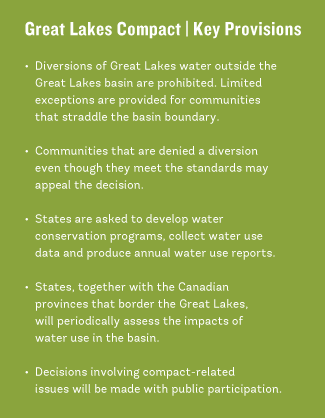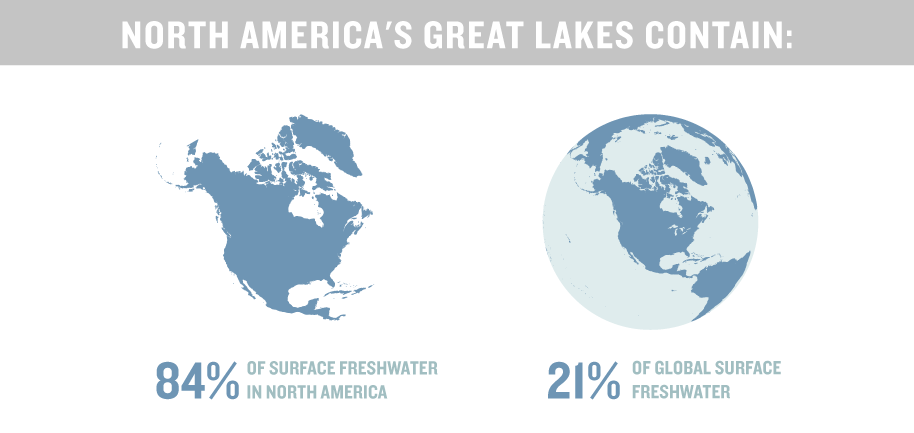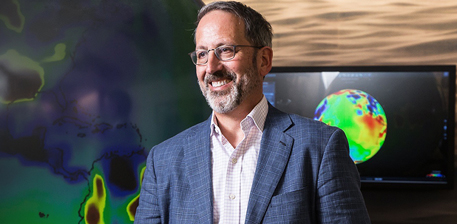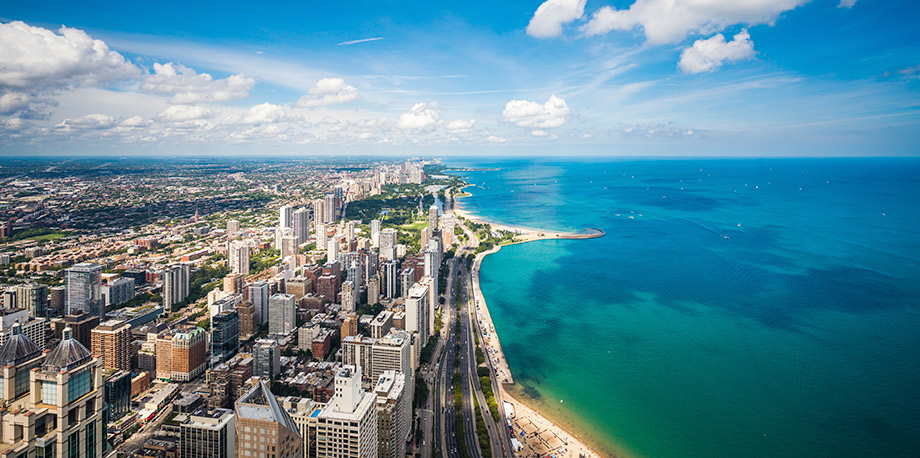August 16, 2018 — On the rocky beach at Little Girls Point County Park in Michigan’s Upper Peninsula, the heavy wash of Lake Superior seeking the shore rolls stones the size of softballs back and forth in the surf.
The power and immensity of the lake seems immutable. If there is anything in nature that will withstand the passing of time, this inland ocean would seem a likely candidate.
Peter Annin knows better. The author of The Great Lakes Water Wars, which examines the fight to protect the lakes from an encroaching and increasingly water-starved world, has stood in the dry ocean bed of Central Asia’s Aral Sea and reflected upon the fragility of such seemingly infinite resources. The Aral was once the fourth largest inland body of water in the world. But the Soviet diversion of Aral water in the 1950s to grow crops dried up 90 percent of the lake in the span of a generation.
“Standing in the middle of the seafloor in a place where the water was once forty-five feet deep, the magnitude of the disaster can be difficult to grasp — nothing but sand stretches off to the horizon in all directions,” Annin wrote in his book. “Photos cannot capture the true extent of this ecological calamity; it even challenges the bounds of the written word.”
At least partly because of the lesson learned from the fate of the Aral Sea, withdrawals from Lake Superior and its four sister lakes are regulated by a hard-won eight-state protective agreement called the Great Lakes Compact and a companion document that provides oversight in Ontario and Quebec.
Hammered out over five years, the compact, aimed at keeping Great Lakes water in the Great Lakes, was approved by the legislatures of all eight states bordering the Great Lakes, Congress and the Canadian provinces and signed into law by President George W. Bush on Oct. 3, 2008.
The soon-to-be-celebrated 10th anniversary of the compact’s creation comes at a time when the durability and effectiveness of the agreement are under close scrutiny. With a major proposed diversion being challenged in court and scientists warning of climate-driven drought in coming decades, the 10-year-milestone offers a timely opportunity to consider whether the compact is working as intended and whether it is likely to withstand the political challenges that will come with fending off a thirsty world.
Pressure Off
The Great Lakes Compact prohibits new or increased diversions outside the Great Lakes basin with limited exceptions for communities and counties that straddle the basin boundary and meet rigorous standards. It asks states to develop water conservation plans, collect water use data, and produce annual water use reports. Great Lakes states as well as Ontario and Quebec are to keep track of impacts of water use in the basin.
A few diversions have been approved under the compact, including withdrawals from Lake Michigan by New Berlin and Waukesha in Wisconsin. The Waukesha diversion of 8.2 million gallons (31 million liters) a day was especially controversial. While the city is outside the basin, it is located in a county that straddles the boundary. The dispute took six years to resolve, with Great Lakes states finally approving the request in 2016.
 The latest test of the document comes with the controversial approval by Wisconsin of a giant Taiwanese-owned factory near Racine. The city requested a diversion from Lake Michigan of 7 million gallons a day (nearly 27 million liters). Of that, according to the state Department of Natural Resources, 5.8 millions gallons (22 million liters) a day will be used by Foxconn Technology Group to manufacture liquid-crystal display screens. The plant, the size of three Pentagons, is projected to create 13,000 jobs.
The latest test of the document comes with the controversial approval by Wisconsin of a giant Taiwanese-owned factory near Racine. The city requested a diversion from Lake Michigan of 7 million gallons a day (nearly 27 million liters). Of that, according to the state Department of Natural Resources, 5.8 millions gallons (22 million liters) a day will be used by Foxconn Technology Group to manufacture liquid-crystal display screens. The plant, the size of three Pentagons, is projected to create 13,000 jobs.
The Wisconsin Department of Natural Resources says the factory’s withdrawal satisfies the terms of the compact — including returning a specified amount of water to the lake. But environmentalists and others disagree. Midwest Environmental Advocates has filed a legal challenge of the agency’s decision to approve the withdrawal. The group argues that the diversion ignores a key requirement in the compact — that all water withdrawn from the Great Lakes basin must be used for public water supply purposes.
Annin, who has just completed a second edition of his book, points out the irony of compact disputes to date all originating within the Great Lakes region and not from more far-flung and ambitious diversion proposals by water-needy entities elsewhere in the world.
Indeed, a private company’s failed 1998 plan to ship Great Lakes water to Asia was a shocking reminder that others in the world had their eyes on the lakes as a solution to their water problems. But such schemes, including ones to pipe water to dry western states such as New Mexico and Arizona, seem to have been short-circuited by the compact, according to Annin.
“The Great Lakes compact has successfully taken the pressure off the Great Lakes Basin,” says Annin. “It’s almost nonexistent right now because of the compact. If anyone was considering it, they have turned away to look for other avenues.”
Others agree that the compact has done what it was intended to do — regulate diversions, encourage water conservation and provide for more data collection on water use.
Todd Ambs, now campaign director of the advocacy group Healing Our Waters – Great Lakes Coalition, was the head of the water division for the Wisconsin Department of Natural Resources and represented the state in the development of the compact. He says the very fact that proposals such as the Waukesha and Foxconn diversions are being debated under the terms of the compact show that the agreement is providing necessary oversight.
Ambs says the compact “is regarded as one of the most significant public water policy achievements in the world.”“You wouldn’t even be grappling with these questions or asking them if you didn’t have the compact,” says Ambs. “These are big issues, big questions and the compact lays out a framework for dealing with them.” Ambs says the compact “is regarded as one of the most significant public water policy achievements in the world.”
Karen Hobbs, senior policy analyst on water issues for the Natural Resources Defense Council, says the compact has provided what has been a largely successful means to manage Great Lakes water. It provided a way for Great Lakes states and Canadian provinces to work together that didn’t exist before.
“I think it’s a seminal milestone in terms of managing the water in the Great Lakes Basin,” says Hobbs.
Hobbs adds, however, that the compact is not without faults. She says implementation has been a slow process for some states, especially efforts to put conservation measures in place.
Some say that the approval of Foxconn reveals weaknesses in the compact’s language. And some say that the approval of Foxconn reveals weaknesses in the compact’s language. While most new diversions are banned under the compact, the Foxconn withdrawal was approved under the provision that allows straddling communities to apply for a diversion. In such cases, the governor of the state has the final say, bypassing approval by all the compact states.
John Dickert, president and CEO of the Great Lakes and St. Lawrence Cities Initiative, says it sets a dangerous precedent. “If we allow cracks in the armor,” he says, “then the armor is no good.”
Hobbs, however, says the compact is relatively young as far as such agreements go and that it should be viewed as a living document that is likely to be fine-tuned over time, often through difficult disputes and legal challenges similar to the Foxconn case.
Todd Jarvis, director of the Institute for Water and Watersheds at Oregon State University, agrees that amendments to such compacts are not unusual and even to be expected. He cites the Colorado River Compact, which dates from the 1920s. That agreement, he says, was signed during a period of abundant water. With the region now under siege by drought, some experts are looking to alter how the compact apportions available water.
“Things change,” says Jarvis. “So what we need to do is go back every few years and reassess where we are.”
In an article in the Environmental & Energy Law & Policy Journal, Noah Hall, an environmental lawyer from Wayne State University, said the changes wrought by climate alterations could require amendments to water compacts.
“While some of these reforms can happen at the state level,” Hall wrote, “or through operational changes in compact administration, more fundamental changes will require revision of existing compacts.” Such changes will not come easy, he added, and “will require leadership and political will.”
Looming Large
Certainly, the future of water on the planet seems fraught enough to make one wonder how the compact will fare as the years pass. The most ardent supporters of the compact say that challenges abound. These include a changing climate that is expected to bring drought as well as heightened political pressure to open up what some view as an invaluable public resource now off limits to the rest of the world.
Water shortages throughout the world are on the rise, among the most visible being in the city of Cape Town in South Africa, where severe drought nearly dried up the drinking water supply. Hall, in his analysis of water compacts and climate change, said global warming is expected to lead to reductions in water supplies throughout the United States. Even the water-rich Great Lakes region will be subject to the trend, he added, with most climate models predicting water levels in the lakes dropping below historic lows in the next century.
Growing threats to the availability of water are already causing consternation in Canada, where droughts have alarmed water experts, according to John Pomeroy, director of the Global Water Futures Program at the University of Saskatchewan.
In a recent article for The Conversation, Pomeroy wrote that the program’s extensive research reveals a bleak water future for large parts of the country, with climate change reducing snow packs and increasing the likelihood of drought.

Data from the U.S. Environmental Protection Agency. Illustration by Sean Quinn. Click to expand.
So it is easy to see why the Great Lakes loom large in the eyes of those who seek to solve their water woes. The lakes are the largest system of fresh surface water on Earth. They hold 84 percent of North America’s surface fresh water and about 21 percent of the world’s supply, according to the U.S. Environmental Protection Agency.
This blue and liquid treasure may be such a powerful allure in a dry future that even a legal document such as the compact will be of little protection. Jay Famiglietti, director of the Global Institute for Water Security at Canada’s University of Saskatchewan, says water scarcity may conspire to force the opening up of the Great Lakes or other water resources as sources for water in the future. He says it is less a matter of politics than practicality, especially when it comes to growing food.

Global Institute for Water Security director Jay Famiglietti suggests that changes in the distribution of water across North America will increase interest in the Great Lakes as a source of water for other regions. Photo courtesy of Steve Anderson | University of Saskatchewan
“My research has shown quite clearly that when you look at the U.S., the upper half is getting wetter while the lower half is getting drier,” says Famiglietti. “Embedded in the drying lower half are our two major food-producing regions, the Central Valley and the High Plains aquifer. The southern halves of both of these are running out of water. So it begs the question about the future. Will we move water to where food systems and food production are optimized, or will we move food production to where the water is?”
Famiglietti says he believes there are better solutions than piping in water from elsewhere, including conservation and growing crops in the proper locations. But he adds that time may be running out and that it may be necessary sooner rather than later to make a decision about tapping a resource such as the Great Lakes to grow food elsewhere in the country.
“I believe that it’s just a matter of time before — assuming we want to continue producing food at current or increased levels in the Central Valley or the High Plains — we will have to bring in water. Obviously, because there won’t be any groundwater left.”
“There is going to come a day when somebody, somewhere, in a loud enough voice, starts talking about hoarding, saying, ‘Wait a minute folks, you’ve got 20 percent of the world’s freshwater? Why would you be able to contain and restrict it in the manner that you have?’” – Pat MulroyAnnin reports in an epilogue to the second edition of his book that others see Famiglietti’s prediction as inevitable and are not happy with what they believe is an effort to lock up an invaluable public resource such as the Great Lakes. Pat Mulroy, a well-known and outspoken Nevada water official, predicted that, in an age of growing water scarcity, the protections afforded by the compact would eventually be breached.
“Anything that is born of fear and paranoia, in essence, has some issues with it,” Mulroy told Annin. “There is going to come a day when somebody, somewhere, in a loud enough voice, starts talking about hoarding, saying, ‘Wait a minute folks, you’ve got 20 percent of the world’s freshwater? Why would you be able to contain and restrict it in the manner that you have?’”
Uncertain Future
Officials in the Great Lakes region recognize such sentiment and point to the compact as a forward-looking document that was put in place not only to encourage conservation but also as a hedge against the day when the world knocks on the door for water.
Environmental lawyer Hall praises that foresight. “The Great Lakes Compact states made a rare move to address a problem before it became a problem,” Hall says.
Dickert, who is also a former three-term mayor of Racine, says the compact gives shape to the desire of the region to protect its most valuable resource in the face of growing threats.
“The water wars are just beginning,” he says. “We just haven’t done a very good job of taking care of our water. The compact has reminded us that water is precious and needs [to be] looked after.”
Shawn Reilly, mayor of Waukesha, speaks about the compact from very personal experience. He helped shepherd the city’s request for a diversion through what ended up being a six-year battle for approval. Satisfying the provisions of the compact proved a complicated and difficult process, but Reilly says that is as it should be. After going through the ordeal, Reilly says he now believes future proposals for diversions from dry regions outside the basin are less likely and would be nearly impossible under the rigorous protections of the compact.
Reilly doesn’t foresee that — or the compact itself — changing, even in the face of growing water shortages.
“I don’t think the compact would change so much that it would allow water to go to Arizona,” Reilly says. “I think the world would really have to change dramatically for the politics to be such that the compact would be changed.”
Reilly adds that the large public works projects that would be required to build pipelines to move water across the country are probably too expensive to be viable. He says Waukesha’s Lake Michigan pipeline is costing US$286 million and isn’t expected to be completed until 2023.
Whatever our political will, nature has a way of undoing the most carefully designed protections that humans devise.Hall says history is on the side of the compact. “Congress has never in U.S. history amended or repealed a compact against the states’ consensus,” he says. But he also warned that, despite this history, Congress could take action in the face of a national water crisis — such as passing a public law that allocates freshwater or enacting a national water policy — that would substantially weaken or negate the protections offered by the compact.
“It’s a nice law,” Hall says, “but it’s just a law.”
So the future remains uncertain even with the compact in place. Whatever our political will, nature has a way of undoing the most carefully designed protections that humans devise and changing the face of places that we, in our naivete, believe would be unchanged forever — a beloved wilderness stand of seemingly indestructible white pine toppled by straight-line winds, a favorite stream turned warm and devoid of trout by a changing climate.
Consider Little Girls Point, where this story began. A few years ago, its beach was the classic example of a wild Lake Superior shoreline with golden stretches of sand intermingled with patches of glistening stones and agates. Above the shoreline rose a green and piney bluff.
Today, the beach is narrow and battered and littered by a tangled nightmare of bare and broken tree trunks washed down a nearby stream by an enormous storm that brought chaos and death up and down the southern shore of Lake Superior in 2016. Bluffs once green with growth are now raw and eroded and bare. Clouds of silt stain the normally crystalline water. It happened in a stormy, violent flash of a few hours on a summer afternoon.
To some extent, the fate of the Great Lakes in the end may be linked to the whim and fury of a natural world that we’ve made even more unpredictable. Regardless of the directions those winds blow, the Great Lakes Compact offers some assurance that any potential change wrought by humans will at least be well-considered. ![]()
UPDATE 8.17.18: The size of the Waukesha diversion was updated to correct a typographical error.
Ensia shares solutions-focused stories free of charge through our online magazine and partner media. That means audiences around the world have ready access to stories that can — and do — help them shape a better future. If you value our work, please show your support today.
Yes, I'll support Ensia!

